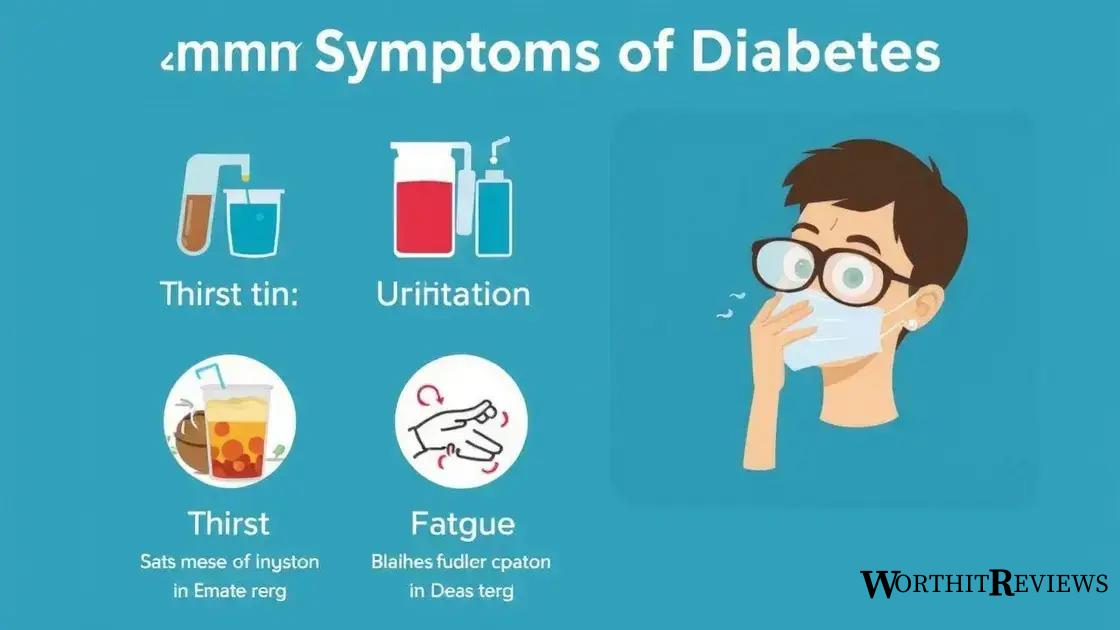Type 1 diabetes is a condition where the pancreas produces little or no insulin, while type 2 diabetes is characterized by insulin resistance; both require effective management through monitoring, nutrition, physical activity, and medication.
Type 1 diabetes and type 2 diabetes are terms we often hear, but what do they truly mean for those affected? Each type presents unique challenges and requires different management strategies. Let’s dive into their distinctions and implications.
What is type 1 diabetes?
Type 1 diabetes is a chronic condition where the pancreas produces little or no insulin. It typically appears in children or young adults, making it crucial to understand its causes and management.
Causes of Type 1 Diabetes
The exact cause of type 1 diabetes is still a mystery. However, it is known to involve an autoimmune response where the body’s immune system attacks insulin-producing cells in the pancreas. Genetic factors may play a role, as having a family history can increase the risk.
Symptoms of Type 1 Diabetes
Common symptoms include excessive thirst, frequent urination, extreme fatigue, and blurred vision. If someone experiences these symptoms, it’s essential to consult a healthcare professional for diagnosis and treatment.
Treatment and Management
Managing type 1 diabetes requires lifelong insulin therapy, which can be administered through injections or an insulin pump. Monitoring blood sugar levels regularly is also crucial to ensure proper control of the condition.
Living with Type 1 Diabetes
Individuals with type 1 diabetes can lead healthy, active lives by maintaining proper treatment and monitoring routines. Education about the condition helps patients make informed choices regarding diet and exercise, contributing to better overall well-being.
Understanding type 2 diabetes

Type 2 diabetes is a metabolic disorder that affects how your body uses insulin. Unlike type 1 diabetes, where the body produces little or no insulin, those with type 2 diabetes often have insulin resistance or do not produce enough insulin.
Causes of Type 2 Diabetes
Several factors contribute to the development of type 2 diabetes, including genetics, obesity, and sedentary lifestyle. Many people with this condition have excess body weight, particularly around the abdomen, which increases the risk of insulin resistance.
Symptoms of Type 2 Diabetes
Symptoms may develop gradually and can include increased thirst, frequent urination, fatigue, and blurred vision. Sometimes, individuals do not notice these symptoms until complications arise.
Treatment and Management
Managing type 2 diabetes often involves lifestyle changes such as improving diet and increasing physical activity. Medications may be prescribed to help control blood sugar levels. Regular monitoring of blood sugar is essential for effective management.
Life with Type 2 Diabetes
Living with type 2 diabetes means making informed choices about food and exercise. It is vital to create a support system that includes healthcare providers, family, and friends to help maintain a healthy lifestyle. Through education and commitment, individuals can effectively manage their condition.
Key differences between type 1 and type 2
Understanding the key differences between type 1 and type 2 diabetes is vital for proper management and treatment. Each type of diabetes has distinct characteristics and requires different approaches to care.
Insulin Production
In type 1 diabetes, the body produces little to no insulin due to the autoimmune destruction of insulin-producing cells in the pancreas. Conversely, type 2 diabetes is often characterized by insulin resistance, where the body does not use insulin effectively, along with varying insulin production.
Age of Onset
Type 1 diabetes commonly develops in childhood or adolescence, while type 2 diabetes typically occurs in adults, although it is increasingly seen in younger populations due to rising obesity rates.
Management Approaches
Management of type 1 diabetes requires regular insulin administration, while type 2 diabetes management often begins with lifestyle changes such as diet and exercise, and may involve medication or insulin therapy if necessary.
Symptoms and Diagnosis
Symptoms of both types can include excessive thirst, frequent urination, and fatigue, but type 1 diabetes symptoms can appear suddenly and severely. Type 2 diabetes symptoms are often more gradual, which can lead to delayed diagnosis and complications.
Long-term Complications
Both types of diabetes can lead to serious health complications, including heart disease, kidney issues, and nerve damage. However, managing type 2 diabetes effectively through lifestyle changes can significantly reduce these risks.
Symptoms to watch for in both types

Recognizing the symptoms of both type 1 and type 2 diabetes is crucial for early diagnosis and effective management. While certain symptoms may overlap, there are distinct signs to be aware of for each type.
Common Symptoms of Both Types
Many individuals with diabetes experience similar symptoms, such as:
- Excessive thirst and dry mouth.
- Frequent urination, especially at night.
- Extreme fatigue and weakness.
- Blurred vision.
- Unexpected weight loss or weight gain.
Specific Symptoms of Type 1 Diabetes
Type 1 diabetes symptoms can develop rapidly, often within days or weeks. Key signs include:
- Extreme hunger that persists despite eating.
- Ketones in the urine, which can lead to diabetic ketoacidosis if not treated.
- Behavioral changes, such as irritability and mood swings.
Specific Symptoms of Type 2 Diabetes
Symptoms of type 2 diabetes may develop more gradually and can sometimes go unnoticed. These include:
- Dark patches of skin, often found in the armpits or neck.
- Numbness or tingling in the hands or feet.
- Increased frequency of infections, such as gum or skin infections.
When to Seek Medical Attention
If you notice these symptoms, particularly if they worsen or are severe, it’s important to consult a healthcare provider for evaluation and testing. Early diagnosis can lead to better management and outcomes.
Managing diabetes effectively
Managing diabetes effectively is crucial for maintaining health and preventing complications. Both type 1 and type 2 diabetes require a structured approach to care that includes monitoring, nutrition, exercise, and medication.
Regular Blood Sugar Monitoring
Monitoring blood sugar levels is essential for both types of diabetes. This involves checking glucose levels multiple times a day using a glucometer. Understanding your blood sugar patterns helps in making informed decisions regarding treatment and lifestyle adjustments.
Healthy Eating
A balanced and nutritious diet plays a vital role in diabetes management. Focus on consuming whole grains, lean proteins, healthy fats, and plenty of fruits and vegetables. It’s important to watch carbohydrate intake and spread meals throughout the day to maintain stable blood sugar levels.
Physical Activity
Engaging in regular physical activity helps regulate blood sugar levels and improves overall health. Aim for at least 150 minutes of moderate aerobic exercise each week, such as walking, swimming, or cycling. Incorporating strength training exercises at least twice a week is also beneficial.
Medication Management
For those with type 1 diabetes, insulin therapy is necessary for survival. Those with type 2 diabetes may require oral medications or insulin to help control blood sugar. It’s important to follow your healthcare provider’s instructions and adjust medications as needed based on blood sugar readings.
Regular Medical Check-Ups
Schedule regular check-ups with your healthcare provider to monitor your diabetes management plan and assess for any complications. Tests may include eye exams, kidney function tests, and foot exams to ensure overall health.
Managing diabetes effectively is key
In conclusion, understanding type 1 and type 2 diabetes is essential for effective management. Regular monitoring of blood sugar, a balanced diet, and physical activity are vital components to control the condition.
With proper medication management and regular check-ups, people with diabetes can lead healthy and active lives. Educating yourself about the symptoms and management strategies can empower you to take charge of your health and minimize complications.
Take the necessary steps today to manage diabetes effectively and enjoy a better quality of life.
